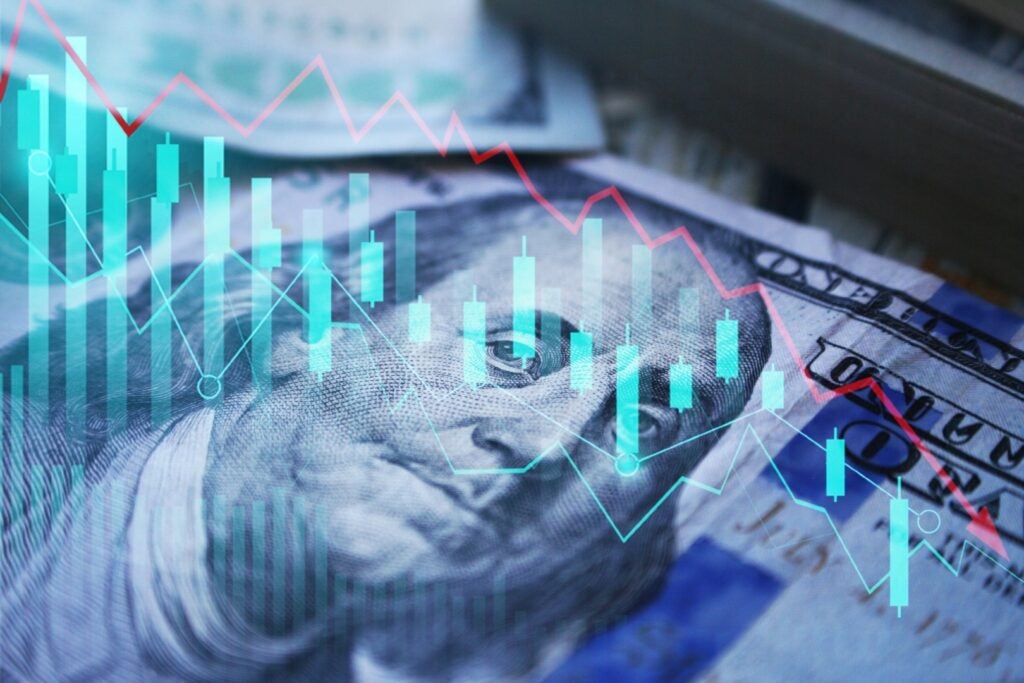
After a spectacular risk-on rally on Wednesday, Wall Street sharply pulled back during Thursday’s trading, as investors digested the 90-day tariff pause and weighed lingering economic risks to the outlook.
Even a sharply lower-than-expected inflation report did little to support risk sentiment — a testament to how susceptible investors remain to economic uncertainty.
The Consumer Price Index fell from 2.8% year-over-year in February to 2.4% in March, below expectations of 2.6% and marking the lowest reading since September 2024. On a monthly basis, inflation was negative by 0.1% — the first decline since May 2020.
While the data bolstered the case for near-term Fed rate cuts — markets are pricing in an 88% chance of a 0.25% move by June — traders remained cautious amid the ongoing tariff drama.
Read Also: Inflation Cools, But ‘Too Soon To Blow The All Clear,’ Economist Says
The S&P 500 dropped 4.8% by midday in New York, erasing about half of Wednesday’s historic gains, which had marked the index’s strongest rally since 2008. The Nasdaq 100 tumbled 5.4%, while small caps in the Russell 2000 sank 5.3%.
Despite the pullback in equities, traditional safe havens like Treasuries and the dollar also fell, raising concerns about waning international confidence in U.S. assets.
The U.S. dollar index — as tracked by the Invesco DB USD Index Bullish Fund ETF UUP — nosedived 2% to the 101 level, its lowest since late September 2024.
Yields on 30-year Treasuries surged by 11 basis points to 4.85%, as bond vigilantes appeared to reassert themselves —effectively flashing red signals in Washington.
Meanwhile, gold continued to deliver stellar returns, with bullion hitting fresh record highs of $3,175 per ounce, up 2.4% on the day. Over the past two sessions, gold has rallied nearly 6%, the biggest two-day gain since March 2020.
On Thursday, the White House announced that the actual tariff rate on Chinese imports will be 145%. Meanwhile, the U.S. House of Representatives passed a budget plan extending the Trump-era tax cuts. Trump welcomed the news, saying it laid the groundwork for what he called “the largest tax and regulation cuts” in American history.
| Major Indices | Price | Chg | |
| Dow Jones | 38,976.38 | -4.0% | |
| S&P 500 | 5,193.60 | -4.8% | |
| Russell 2000 | 1,810.18 | -5.3% | |
| Nasdaq 100 | 18,119.84 | -5.4% | |
According to Benzinga Pro data:
- The SPDR S&P 500 ETF Trust SPY fell 5.2% to $517.46.
- The SPDR Dow Jones Industrial Average DIA fell 4% to $389.66.
- The tech-heavy Invesco QQQ Trust Series QQQ sunk 5.5% to $440.99.
- The iShares Russell 2000 ETF IWM tumbled 5.3% to $179.66.
- S&P 500 sectors with largest drops were Energy Select Sector SPDR Fund XLE, down 6.7%; Technology Select Sector SPDR Fund XLK, down 6% and Consumer Discretionary Select Sector SPDR Fund XLY, down 5.8%.
- There were only 22 gainers within the S&P 500, with Newmont Corp. NEM rallying 3.3%, amid rising gold prices.
- Major losers included CarMax Inc. KMX down 20%, Microchip Technology Inc. MCHP, down 14%, and Celanese Corp. CE, down 14%.
- Magnificent Seven were all trading deeply in negative territory, with the group shedding nearly a trillion of combined market value.
- NVIDIA Corporation NVDA
Market Cap Loss: $209.24 billion
Daily Change: -7.50% - Apple Inc. AAPL
Market Cap Loss: $181.32 billion
Daily Change: -6.07% - Amazon.com Inc. AMZN
Market Cap Loss: $129.62 billion
Daily Change: -6.40% - Microsoft Corporation MSFT
Market Cap Loss: $124.82 billion
Daily Change: -4.30% - Meta Platforms Inc. META
Market Cap Loss: $102.56 billion
Daily Change: -6.91% - Tesla Inc. TSLA
Market Cap Loss: $87.47 billion
Daily Change: -9.99% - Alphabet Inc. GOOG
Market Cap Loss: $79.85 billion
Daily Change: -4.10%
Read Now:
Photo: Shutterstock Professional via Shutterstock
Market News and Data brought to you by Benzinga APIs
© 2025 Benzinga.com. Benzinga does not provide investment advice. All rights reserved.
